COCACOLA可口可乐
可口可乐COCA-COLA的品牌故事

可口可乐COCA-COLA的品牌故事1、可口可乐是一个典型的国际品牌,它具有一个经典品牌所应有的每一个特性。
----可口可乐品牌诞生于19世纪80年代末期,当时大规模运输开始出现,标有品牌的商品得以跨地区进行营销。
其他的一些著名品牌,如柯达、桂格、阳光、西尔斯等,其历史也同样可以追溯到那个商业快速发展的时期。
法国、英国、美国发达国家几乎在同一时期首次建立起正式的商标注册体系。
----可口可乐品牌的基本诉求点:“可口可乐令……满意,可口可乐使人愉快,是美味、健康的饮料”,一个多世纪以来一直未变。
同样,可口可乐这个品牌名以及主要的标志,手写体流畅且与众不同的COCA-COLA,都未曾改变。
----可口可乐品牌的所有者一直认为:树立品牌不同于贴标签,树立品牌实际上是创造一种与众不同的个性,“我们成功的原因在于我们创造出的友善的氛围,消费者实际上是想与可口可乐融为一体。
”----可口可乐公司通过有效、一致的广告和促销,注重包装和视觉形象(例如,1915年推出曲线瓶,1931年完成有关企业形象的标准化手册),不断强化品牌形象。
即使COCA-COLA译为其他文字时,可口可乐公司也尽力保持着品牌形象在视觉上的一致性。
----虽然如此,可口可乐品牌同时也在不断发展,以满足不断变化的口味和环境的需要。
如出现了新的包装,罐装和可弃瓶包装;为适应不同的语言及文字,可口可乐的标志有了特殊的翻译;近年来,为迎合不同的口味和不同的生活方式,又推出了不同配方、不同味道的可乐——如健怡可乐、无咖啡因可乐和樱桃味可乐。
----可口可乐不定期有一个相当独特的特性:它有两个品牌名称,可口可乐(COCA-COLA)和可口(COKE),两个品牌指的是同一种商品,它们可以换用,并且都是注册商标。
2、可口可乐是世界第一品牌。
100多年来,谨慎的管理和发展方式保持了品牌的一致性。
今天的可口可乐品牌与19世纪80年代推出时仍十分相似。
----可口可乐的博物馆:品牌资产有形化到美国亚特兰大,千万别错过有美国汽水历史博物馆之称的“可口可乐世界”,在里面走一趟,便可了解这个每天在全球卖出6亿100万杯的跨国企业的百年发展史。
可乐coke和cola区别

可乐coke和cola区别
区别一:意思不一样
1、Cola一般都指可乐饮料;一杯(或一罐、一瓶)可乐;
2、Coke除了可乐之外,还有焦炭;(使)炭化的意思
区别二:用法不一样
1、cola在表示可乐的时候,只要小写即可;
2、而coke表示饮料的时候首字母必须大写,写成Coke。
区别三:范围不一样
1、cola特指“可口可乐”,不代表别的可乐;
2、Coke泛指所有可乐,熟知的“可口可乐”的英文为Coca Cola。
例句:
1、I slaked my thirst with three cans of Coke。
我喝了3罐可乐解渴。
2、The most effective new botanicals are extracts from cola nut and marine algae。
这种极其有效的新型植物制剂是从可乐果和海藻中提炼出来的。
可口可乐产品配料分析报告

可口可乐产品配料分析报告一、引言可口可乐(Coca-Cola)作为全球知名的饮料品牌,深受消费者喜爱。
然而,对于可口可乐的配料,消费者常常提出疑问。
本报告对可口可乐的产品配料进行分析,以揭示其中的真相。
二、可口可乐的主要配料可口可乐的主要配料是碳酸水、高果糖玉米糖浆、焦糖色、磷酸、咖啡因和自然香料。
下面对这些配料逐一进行分析。
1. 碳酸水:碳酸水是可口可乐的主要基础成分,它为饮料注入了起泡和清凉口感。
碳酸水是一种含有二氧化碳的水溶液,没有添加其他化学物质,因此无害于人体。
2. 高果糖玉米糖浆:高果糖玉米糖浆是一种甜味剂,用于提供甜味。
它由玉米淀粉经过酶解反应得到。
与传统白砂糖相比,高果糖玉米糖浆具有更高的甜度,在食品工业中被广泛使用。
然而,长期大量摄入高果糖玉米糖浆与肥胖和糖尿病等健康问题有关。
3. 焦糖色:焦糖色是一种食品着色剂,为可口可乐赋予了深棕色的外观。
焦糖色通常由糖类加热至变为焦糖,并与酸性物质(如磷酸)反应而形成。
研究表明,焦糖色在高温下产生一种化合物称为4-甲基咪唑(4-methylimidazole,简称4-MEI),在动物实验中有致癌的潜力。
然而,焦糖色在可口可乐中的含量经过严格的安全评估,远低于对人体造成危害的剂量。
4. 磷酸:磷酸是一种调味剂,在可口可乐中被用于调整饮料的酸碱度和味道。
磷酸是一种酸性物质,摄入过量可能对牙齿健康造成影响。
然而,可口可乐中的磷酸含量经过合理控制,不会给人体健康带来明显的风险。
5. 咖啡因:可口可乐中的咖啡因含量相对较低,主要是为了提供饮料的提神作用。
咖啡因对于大部分人群而言是安全的,但过量摄入可能导致神经紧张、失眠等不良反应。
6. 自然香料:自然香料是从植物、动物或微生物中提取的天然化合物,主要用于增加可口可乐的口感和风味。
可口可乐公司遵循严格的食品安全准则,确保自然香料的安全性和适用性。
三、结论经过对可口可乐的产品配料进行分析,我们可以得出以下结论:1. 可口可乐的产品配料主要由碳酸水、高果糖玉米糖浆、焦糖色、磷酸、咖啡因和自然香料组成。
可口可乐简介

一、简介可口可乐公司(Coca-Cola Company)成立于1892年,总部设在美国乔亚州亚特兰大,是全球最大的饮料公司,拥有全球48%市场占有率以及全球前三大饮料的二项(可口可乐排名第一,百事可乐第二,低热量可口可乐第三),可口可乐在200个国家拥有160种饮料品牌,包括汽水、运动饮料、乳类饮品、果汁、茶和咖啡,亦是全球最大的果汁饮料经销商(包括Minute Maid品牌),在美国排名第一的可口可乐为其取得超过40%的市场占有率,而雪碧(Sprite)则是成长最快的饮料,其它品牌包括伯克(Barq)的root beer(沙士),水果国度(Fruitopia)以及大浪(Surge)。
可口可乐公司是全球最大的饮料公司。
除全球最有价值品牌可口可乐外,可口可乐公司还生产全球前5大饮料中的另外3个,包括健怡可口可乐、雪碧和芬达,以及大量其他种类的饮料,包括无糖饮料、水、果汁和果味饮料、茶、咖啡和运动饮料等。
通过全球最大的分销系统,200多个国家的消费者每日享用超过13亿杯可口可乐产品。
二、理念当我们能够使员工快乐振奋而有价值,我们就能够成功地培育和保护我们的品牌,这就是我们能够持续地为公司带来商业回报的关键!老朋友无时无处不在你身边三、可口可乐之父因为他相信将来这种饮料主要是在饮料机中的销售。
1892年成立了可口可乐公司,Kandler被称为“可口可乐之父”。
在1919年,Elntst-Woodruff以250万美元从Asa Kandler的继承人手里买下Coca-Cola公司,到了1923年,他儿子Robert W.Woodruff,也就是Coca-Cola历史上最重要的人物之一,成为Coca-Cola的CEO,Woodruff开始与公司装瓶特许经营商一起努力,无论消费者何时向地想要Coca-Cola都能得到满足,他推动装瓶商使饮料“需要时随手可得”并且强调如果Coke不能在消费者口渴时立刻得到,那么市场将永远失去。
可口可乐介绍
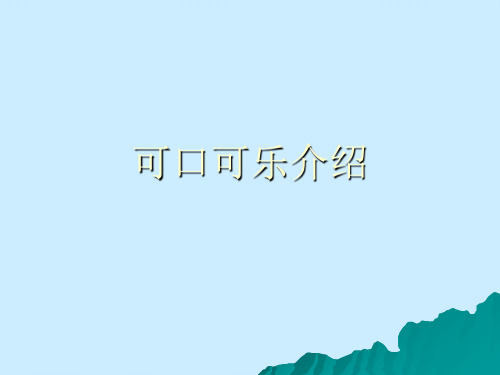
soft drink. At present the Coca-Cola 目前可口可乐中国系统员工已超过30,000人,99%的员工为中国本地员工。
Coca-Cola China system in China has donated more than 50 million RMB, the support of many national and regional social
YiShen thirst.
1960年进入美国最大的100家工业公司的行列;1983 年居第48位。
In 1960 to enter the United States of the 100 largest industrial company ranks, article 48 in 1983.
1)Do you know any competitor with coca-cola ?
5 per cent respectively and 12.
可口可乐是中国最著名的国际品牌之一,在中国软 收索材料:濮阳曦朦 李念
1960-1983, this company net sales of assets, and the annual growth rate for 12. 2)what is Coca-cola made of ?
1960~1983年,该公司的销售额、资产额和净收入的 年均增长率分别为12.2%、11.5%和12.3%。
1960-1983, this company net sales of assets, and the annual growth rate for 12.2%, 11.5 per cent respectively and 12.3%.
可口可乐

发展业务
• Woodruff还开始发展Koka-kola的国际业务, 主要是通过出口,他最知名的举措可能是 这样的一个决策,即响应二战初艾森威尔 将军的号召,保证每个军人在任何地方都 可以以5美分的价格得到一瓶Koka-kola", 而不管其成本为多少。Koka-kola的装瓶工 厂,随着美国军队推向全世界,这一举措 使Koka-kola在欧洲和亚洲国家获得了占绝 对优势的市场份额,,并且一这一优势地 位一直保持到1991年
可口可乐的历史
1886年5月8日他想发明一种饮料,一种让很多需要 补充营养的人喜欢喝的饮料。那天,他正在搅拌作 好了的饮料,发现它具有提神、镇静的作用以及减 轻头痛,他将这种液体加入了糖浆和水,然后加上 冰块,他尝了尝,味道好极了,不过在倒第二杯时, 助手一不小心加入了碳酸水(苏打水)(二氧化碳 +水)这回味道更好了,合伙人罗宾逊 罗宾逊(Flank 罗宾逊 M.Lobinson)从糖浆的两种成分,激发出命名的 灵感,这两种成分就是古柯 古柯(Koka)的叶子和可拉 古柯 可拉 (Kola)的果实,罗宾逊为了整齐划一,将Kola的 C 改K,然后在两个词中间加一横,于是KokaKola便诞生了,第一份可口可乐售价为五分美元。
可口可乐首席执行官Muhtar Kent
• 一个多月前,穆泰康去了 北极。随后,他匆匆赶往 丹麦参加哥本哈根气候大 会。作为为数不多的参加 气候大会的全球500 强 CEO,穆泰康决定和他的 前任内维尔·艾斯戴尔一样, 为保护环境而向气候宣战: “人们迟早会明白—发展 低碳经济势在必行。通过 参与公众及政治讨论,可 口可乐公司想促使建立一 个公平、广泛、有效的框 架来保护气候。”
挑战者 :百事可乐
据新生代市场监测机构实施的、"中国市场 与媒体研究(CMMS)"的连续监测, 可口可乐凭借其"拉网式"的市场攻略, 全国布网,层层推进,市场渗透率(饮 用某品牌可乐的消费者人数与可乐消费 者总数之比)一直"遥遥领先"于百事可 乐。1999年、2000年其全国20个城市 的渗透率分别是83.9%和85%,而百事 可乐则分别只有65.5%和67.9%.但仔细 分析我们会发现,百事可乐市场渗透率 的增长略高于可口可乐,前者是3.7%, 而后者只有1.3%,而且这种趋势还在润 物细无声般的进行着,到2004年前者达 到了89%,后者竞达到了81%,真是让 人有后浪推前浪的沧桑感触了。特别是 最近媒体更是连篇累牍的报道百事的股 本市值百年头一次超过可口,这更让人 联想到新生代百事的锋芒锐利和可口可 乐的无奈颓势。
coke的成分

coke的成分
Coke,通常指可口可乐(Coca-Cola),是由可口可乐公司生产出品的一种碳酸饮料。
以下是可口可乐的一些常见成分:
1. 碳酸水:这是可口可乐的主要成分之一,它是将二氧化碳溶于水中制成的。
2. 高果糖玉米糖浆:这是一种甜味剂,用于给可口可乐提供甜味。
3. 焦糖色素:这是一种给可口可乐带来棕色颜色的色素。
4. 磷酸:这是一种酸味剂,用于给可口可乐提供酸味。
5. 咖啡因:这是一种刺激性物质,能提供一定的提神作用。
6. 香草醛:这是一种香草味的香料,给可口可乐带来特殊的香草味道。
7. 橘子油:这是一种从橘子皮中提取的油,给可口可乐带来橘子的风味。
需要注意的是,不同地区和国家的可口可乐配方可能会略有差异,以适应当地的口味和法规要求。
此外,可口可乐还可能包含其他成分,如防腐剂和稳定剂等,以确保产品的质量和稳定性。
如果你对特定可口可乐产品的成分有更详细的需求,建议查阅该产品的包装或官方网站上的成分列表,以获取最准确的信息。
从Coca-Cola到可口可乐的语言文化意义
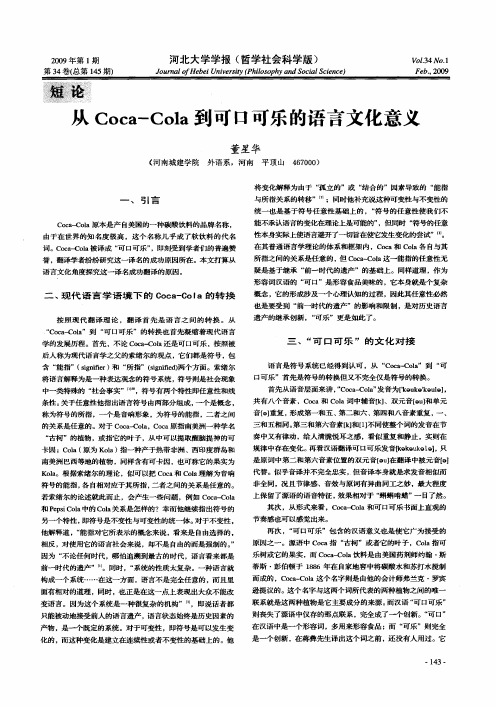
三 、“可 口 可 乐 ” 的 文 化 对 接
中一 类特殊 的 “ 会事 实”… , 号有 两个特 性即任 意性 和线 社 符 条性 。 关于任 意性他 指 出语言符 号 由两部分 组成 , —个 是概 念 ,
称为符 号的所 指 ,—个 是音 响形象 ,为 符号 的能指 ,二者之 间 的关 系是 任意 的。对 于 C c- oa C c 原指南 美洲 一种学 名 oa- l, o a C “ 古柯 ”的植物 , 指它 的叶子 , 中可 以提取 醒脑提 神 的可 或 从
三和 五相 同。 三和 第六音 素【】 l不 同使整个 词 的发 音在 节 第 k和【】
奏 中又有 律动 ,给人 清脆 悦耳之 感 ,看 似重复 和静 止 ,实 则在
规律 中存 在变化 。 再看 汉语 翻译可 口可乐 发音 【 k u 9 0 , k 9 k l 】 只 9
卡 因 ;C l 原 为 K l) 一种产 于热 带非洲 、 印 度群 岛和 oa( oa 指 西
南 美洲 巴西等地 的植物 ,同样含有 可卡 因 ,也可称 它 的果 实为 K l。根 据索绪 尔 的理论 ,似可 以把 C c 和 C l 理解 为音 响 oa oa oa
是原 词 中第二和 第六 音素 位置 的双元 音 【u在 翻译 中被 元音 【】 9】 9 代替 。似 乎g' C不 完全忠 实 ,但音 译本 身就是 求发 音相似 而 - e  ̄ 非全 同 ,况且 节律感 、音效 与原词有 异 曲同工 之妙 ,最 大程度 上保 留了 源语的语 音特 征 , 果相 对于 “ 效 蝌蝌 啃蜡 ” 目了然 。 一
能不 承认语言 的变化在理 论 t 是可能的 ” ,但 同时 “ 符号的任意 性本 身实际上使 语言避开 了一切 旨在使 它发生变化 的尝 试”… 。 在 其普 通语言 学理论 的体 系和框 架 内 ,C c oa和 C l 自与其 o a各 所指 之 间的关 系是任 意的 , C c— oa 但 oa C l这一 能指 的任 意性 无
可口可乐名字的由来
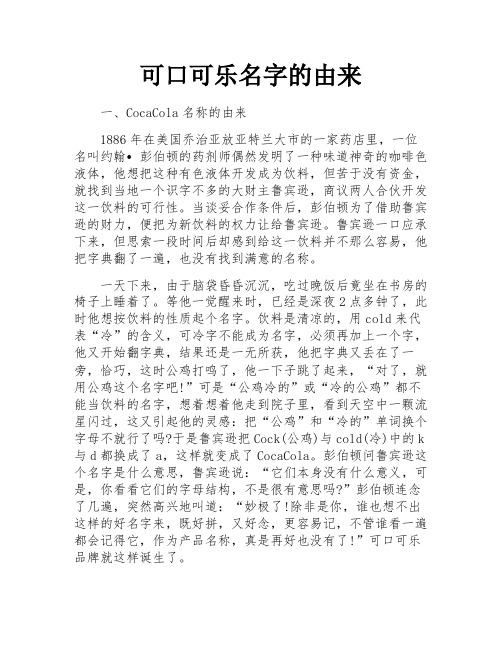
可口可乐名字的由来一、CocaCola名称的由来1886年在美国乔治亚放亚特兰大市的一家药店里,一位名叫约翰•彭伯顿的药剂师偶然发明了一种味道神奇的咖啡色液体,他想把这种有色液体开发成为饮料,但苦于没有资金,就找到当地一个识字不多的大财主鲁宾逊,商议两人合伙开发这一饮料的可行性。
当谈妥合作条件后,彭伯顿为了借助鲁宾逊的财力,便把为新饮料的权力让给鲁宾逊。
鲁宾逊一口应承下来,但思索一段时间后却感到给这一饮料并不那么容易,他把字典翻了一遍,也没有找到满意的名称。
一天下来,由于脑袋昏昏沉沉,吃过晚饭后竟坐在书房的椅子上睡着了。
等他一觉醒来时,已经是深夜2点多钟了,此时他想按饮料的性质起个名字。
饮料是清凉的,用cold来代表“冷”的含义,可冷字不能成为名字,必须再加上一个字,他又开始翻字典,结果还是一无所获,他把字典又丢在了一旁,恰巧,这时公鸡打鸣了,他一下子跳了起来,“对了,就用公鸡这个名字吧!”可是“公鸡冷的”或“冷的公鸡”都不能当饮料的名字,想着想着他走到院子里,看到天空中一颗流星闪过,这又引起他的灵感:把“公鸡”和“冷的”单词换个字母不就行了吗?于是鲁宾逊把Cock(公鸡)与cold(冷)中的k 与d都换成了a,这样就变成了CocaCola。
彭伯顿问鲁宾逊这个名字是什么意思,鲁宾逊说:“它们本身没有什么意义,可是,你看看它们的字母结构,不是很有意思吗?”彭伯顿连念了几遍,突然高兴地叫道:“妙极了!除非是你,谁也想不出这样的好名字来,既好拼,又好念,更容易记,不管谁看一遍都会记得它,作为产品名称,真是再好也没有了!”可口可乐品牌就这样诞生了。
实际上,这两个字是有意义的,一个代表南美洲的一种药草,一个代表非洲出产的一种果子,CocaCola是药草与果子名称的结合。
品牌不仅要使人们区别出同类商品中不同厂家,还要让人们对他们识别出的产品留下印象和记忆。
一方面,CocaCola品牌名字简洁明了,符合人们的记忆规律和特点,另一方面,Coca与Cock相似,Cola与Cold相似,一般文化程度的人都认识Cock与Cold,这样更容易加深人们对CocaCola印象。
可口可乐品牌介绍

可口可乐品牌档案标志:中文名称:可口可乐英文名称:coca cola英文网站:中文网站:创立时间:1887年注册地:美国乔治亚州亚特兰大品牌家族:健怡可乐、醒目、雪碧、芬达、酷儿、美汁源、健康工房、茶研工坊、雀巢冰爽茶、冰露、天与地、水森活、冰露、怡泉。
品牌价值排行:(品牌价值排行来自于美国《商业周刊》)1886年5月,可口可乐首次面世于美国佐治亚州亚特兰大市的雅各布药店,至今已121岁了.可口可乐公司是全世界最大的饮料公司,也是软饮料销售市场的领袖和先锋,透过全球最大的分销系统,畅销世界超过200个国家及地区,每日饮用量达10亿杯,占全世界软饮料市场的48%,是世界第一品牌,品牌价值已达七百多亿美元。
一、创办人与重要人物约翰.彭伯顿1886年,约翰. 彭伯顿在乔治亚州的亚特兰大发明了随后风靡全球的可口可乐。
他挑选了几种特别成分,然后把它们混合加热,配制成一种奇特的糖浆,他感觉美味可口,于是就把这种糖浆带到了雅各药房,将糖浆加水5分钱一杯。
一个偶然的机会,药店的伙计把糖浆兑上了苏打水并且加了几块冰给了客人,结果客人赞不绝口,于是一种怡神畅快的饮料就诞生了。
波兰克.罗宾逊彭伯顿有个会计,名叫波兰克.罗宾逊,他给这种全新的饮料起了个响亮的名字“可口可乐”,并设计书写出这个现金世界举世闻名的世界著名商标。
阿萨.坎德勒1888年彭伯顿把可口可乐的秘方卖给了一个名叫阿萨.坎德勒的商人,坎德勒很快成立了一家公司,专门生产和经营可口可乐。
坎德勒是个市场营销天才,他使出种种新颖的手法推广产品甚至把装运可口可乐的桶刷成引人注目的红色,越来越多的人发现了新的怡神畅快的饮料,可口可乐开始遍布美国各地。
罗伯特.伍德鲁夫1919年坎德勒把公司卖给了一群投资商,而罗伯特.伍德鲁夫很快成为了公司的新总裁。
伍德鲁夫的目标是任何人在任何时候和任何地方都能享用到冰凉爽口的可口可乐。
在他的领导下,世界各地纷纷建立装瓶工厂,可口可乐成为真正的全球品牌。
可口可乐和百事可乐

可口可乐和百事可乐的比较分析12市场营销本3班徐炜宏40 刘阳凤39 霍达06可口可乐(CoCa-CoLa)是一种碳酸型饮料,诞生于1886年。
可口可乐,由药剂师约翰·彭伯顿(John Pemberton)在美国佐治亚州的亚特兰大市研制而成。
1885年,他为法国葡萄酒可乐注册了商标,“一种理想的神经活络滋补剂”。
1886年,彭伯顿对法国葡萄酒可乐做了一些改革,即加入苏打水并将其放入用过的啤酒瓶中,称其为可口可乐。
他将这种混合饮料更多地用来治头痛而不是用来恢复精力,尤其是当人们暴饮暴食后。
一个偶然的机会,一位药商发现这种糖浆加入二氧化碳后味道更好。
为尽快推广产品,彭伯顿与富商鲁宾逊合伙开发,为产品起名为CoCa-Cola,CoCa是南美的一种药草,CoLa是非洲的一种果子。
1886年5月在《亚特兰大日报》上,打出了第一次广告:“可口可乐,可口!清新!欢乐!活力!是新潮苏打饮料,含有神奇的可卡叶和著名的可乐果的特性”。
简短有力的广告,开创了现代广告的先河。
可口可乐当时的售价为每杯5美分。
后来,彭伯顿的健康每况愈下,他以2300美元的价格把可口可乐卖给了阿萨??坎德勒(Asa Candeler )。
1892年,坎德勒组建了可口可乐公司,它开发了一种至今仍沿用的瓶装系统,在随后的25年里他独自引领着饮料业的发展方向。
1899年,坎德勒在田纳西州建成了第一家瓶装厂,从而结束了可口可乐只在苏打亭散卖的历史。
可口可乐“99%是水,其余的是每桶不足一美元的药物”——马克·吐温在《镀金岁月》一书中这样说到。
1916年,坎德勒离开可口可乐公司去竞选亚特兰大市的市长;1919年,可口可乐以2500万美元卖给亚特兰大的商业集团。
该集团的负责人是银行家厄内斯特??伍德拉夫(Ernest Woodruff),直到今天可口可乐仍掌握在伍德拉夫家族手中。
1930年,可口可乐在28个国家有了64个经销商。
二战伊始,伍德拉夫发表特别声明:“不管我国的军队在什么地方,也不管公司要花多少成本,我们一定能让每个军人只花5美分就能买到一瓶可口可乐”。
可口可乐

批发系统 KA(Key Account)系统
旅游 实物
刮卡 集卡 海报 促销
堆头
展示
关键人 奖励
直营渠道系统
生动化 用品 集卡 套餐 进货
桌椅 101(CS)系统
生动化 陈列
1、免费品尝 2、特价销售 3、增量包装 4、联合促销 5、有奖销售 6、瓶盖兑奖
可口可乐广告制作的原则
• 广告由coke总部根据各地区销售情况、 市场预测及销售计划进行全权负责。 • 根据目标人群,目标市场进行广告设 计(目标为广大青年男女) • 根据时代特征进行广告设计 • 根据销售地区设计符合不同文化传统 的广告词
最初,为了全面 控制市场,可口可 乐物流全部由自身 瓶装厂完成。
(1)没有推行物流管理体系,仓储部管 仓库,运输部管车辆运输,采购部只 管原材料物料采购,生产部只管生产 计划,部门相互独立的。 (2)各部门经理都是平级,没有一个在 中间进行协调,包括销售部和市场部 各做各的。彼此的交流沟通不足,内 部信息流不通畅弊病不断暴露。
浓缩液制造商 瓶装封面 图示如下: 广告纸 塑料瓶 塑料盖 吸管 玻璃瓶 玻璃盖 销售商 瓶装商
自来水 纸箱 包装箱
2.3.1营销策略
4PS策略
A.大红广告(Paint it in red)。凡是有消费者的 地方,就有漆着大红可乐商标的广告牌、广告墙、广告霓 虹灯、广告页等各项平面/立体广告来吸引消费者的目光。 B.渴望产品(Prefered product)。强调本身产品 的优质与特色超越平凡,保证可满足「垂手可得的渴望」 (within an arm's reach of desire)。 C.尊荣形象(Persuasive image)。品牌形象的强 化与维护一直为可口可乐行销重点中的强化要务,要让全 世界消费者肯定其「唯我独尊」软性软料领导者的形象, 并使顾客们与有荣焉。 D.物超所值(Priced relative to value)。付得 起的尊贵享受,体验可口可乐的超值感觉。
可口可乐公司简介

400
200 0 171 130
April
130
May
129
June
中国業績分析,
6,000
以口味別區分
P each
聰明的行銷策略:季節並不影響銷售, 新
5,000
W hite G rape A pple O range
口味上市再搭配促銷活動, 掀起購買熱 潮.促使銷量大幅成長!!
Jr. H i h g
HC M
E l m e n t ry e a
Jr. H i h g
HCM
(Source : Consumer tracking survey)
產品剛上市的業績實在是“旺”
中國業績一路長紅
(Unit: U/C-'000)
800 600
YTD June Total: 1,199 650
产品系列
产品系列
碳酸
茶
咖啡
可口可乐
非碳酸
矿泉水
果汁
Swire Coca-Cola Taiwan
产品系列
Swire Coca-Cola Taiwan
品牌文化
1886年约翰 彭伯顿调整 出可口可乐 世界最知名 的瓶子可乐 弧形瓶
Swire Coca-Cola Taiwan
精彩赞助
可口可乐是遍及全球的 饮料公司,是诸多体育 赛事的长期合作伙伴, 其中包括NBA F1 环法 自行车赛 奥运会等
20 12
M ay 11~ 12
26 10
M ay 25~ 26
30 18
0
Jun . 8~ 9 J u n .2 2 ~ 2 3
12 8 2
可口可乐音译词的来历

ቤተ መጻሕፍቲ ባይዱ
可口可乐曾于1949年离开中国,于1979年重返中国,沿用同样的中文名字。现在,24个装瓶厂提供12亿中国人饮用可口可乐,中国每年人均饮用5瓶可口可乐
(二)原来1927年可口可乐刚进中国时的中文译名叫"蝌蚪啃蜡",这种名字用在饮料上,接受程度可想而知,喝可乐是会想到蝌蚪,太恐怖了,有谁敢喝啊。到了1930年公司开始向社会征集中文的译名,有个叫蒋彝的中国留英学生把它翻译成"可口可乐",听说评审一看到这个译名就说不要看别的了,就是它!蒋彝先生原来是学化学的,后来还当了县长后,又觉得搞政治没意思,就去英国留学了。
(一)可口可乐。这几个字的发音十分近似英语中“Coca―Cola”的发音,意思是“美味可口和开心快乐”。
可口可乐公司企业文化
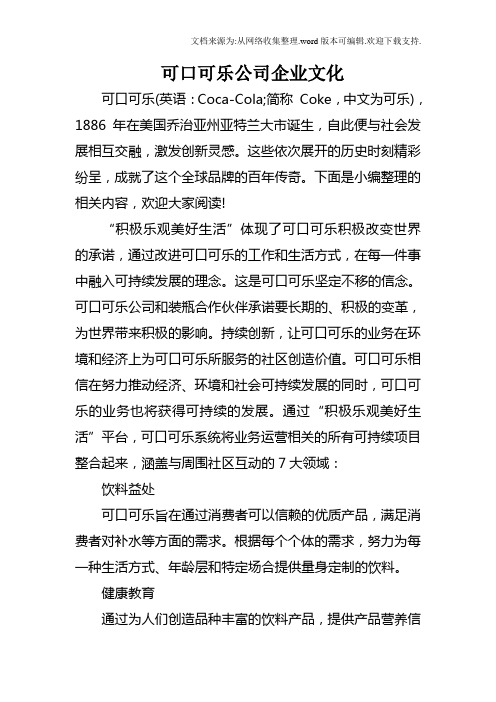
可口可乐公司企业文化可口可乐(英语:Coca-Cola;简称Coke,中文为可乐),1886年在美国乔治亚州亚特兰大市诞生,自此便与社会发展相互交融,激发创新灵感。
这些依次展开的历史时刻精彩纷呈,成就了这个全球品牌的百年传奇。
下面是小编整理的相关内容,欢迎大家阅读!“积极乐观美好生活”体现了可口可乐积极改变世界的承诺,通过改进可口可乐的工作和生活方式,在每一件事中融入可持续发展的理念。
这是可口可乐坚定不移的信念。
可口可乐公司和装瓶合作伙伴承诺要长期的、积极的变革,为世界带来积极的影响。
持续创新,让可口可乐的业务在环境和经济上为可口可乐所服务的社区创造价值。
可口可乐相信在努力推动经济、环境和社会可持续发展的同时,可口可乐的业务也将获得可持续的发展。
通过“积极乐观美好生活”平台,可口可乐系统将业务运营相关的所有可持续项目整合起来,涵盖与周围社区互动的7大领域:饮料益处可口可乐旨在通过消费者可以信赖的优质产品,满足消费者对补水等方面的需求。
根据每个个体的需求,努力为每一种生活方式、年龄层和特定场合提供量身定制的饮料。
健康教育通过为人们创造品种丰富的饮料产品,提供产品营养信息并对消费者进行健康教育,以及支持体育运动,可口可乐帮助人们享受积极健康的生活。
社区可持续发展可口可乐是全球企业,但是可口可乐植根于每一个所运营的社区。
通过以发展经济、提高生活水平、创造机遇为目的的多样化社区项目,致力于促进本土社区的可持续发展。
工作场所像所服务的多样化市场一样,可口可乐为员工建立开放的工作环境。
可口可乐提供一个健康和安全的工作场所,遵循国际认可的人权准则,努力造就一个能够激发员工创造优异结果的环境。
气候保护可口可乐志在成为饮料行业在能源节约和气候保护上的领导者。
可口可乐承诺业务增长的同时,不增长生产运营中的碳排放。
可持续包装可口可乐对世界有个愿景,可口可乐的包装材料能够被作为有价值的资源,得以回收供未来使用。
通过减少使用、回收和再利用,可口可乐在包装材料的循环利用中创造价值,并正在将可口可乐的愿景转化为现实。
可口可乐标志含义

可口可乐标志含义可口可乐(Coca-Cola)标志是世界上最具标志性的商标之一。
这个简单而又独特的标志被广泛认可,并且代表着可口可乐作为全球饮料巨头的知名度和影响力。
在探索可口可乐标志的含义之前,我们需要了解这个标志的历史和发展过程。
可口可乐标志最早出现在1890年代,最初的设计着重于品牌的可视辨识度和商标的易读性。
标志采用了粗体字体,将“Coca-Cola”两个单词排列在一起,并使用朗酷兰拉球形字作为字体。
这个标志的设计简单明了,容易辨识,使消费者能够轻松地与品牌进行关联。
然而,这个简单的标志并没有经过多大变化,它已经成为公司在全球饮料市场的象征。
在20世纪20年代,可口可乐决定对其标志进行一些改进。
标志的设计师罗伯特·伍德瑞夫将可口可乐的标志与一个红色和白色的波浪形图案结合在一起。
这种波浪形的设计图案为标志增添了一丝活力和动感。
红色和白色的波浪形设计在可口可乐标志中的使用具有多重含义。
首先,红色是可口可乐的主要品牌颜色,代表着激情、能量和动态。
这种鲜艳的红色在标志中的运用传达了可口可乐所提供的愉悦和兴奋感。
其次,白色的波浪形设计象征着清新和可口可乐品牌的优质特性。
这种简单而干净的图案,使整个标志看起来更加吸引人,并与红色形成鲜明的对比。
可口可乐标志中的波浪形设计还具有一种亲和力的因素。
波浪形图案类似于一个微笑的弧线,让人们联想到愉快和友好。
这个微笑的形状可以吸引消费者,并与可口可乐品牌的形象相呼应。
这种友好和愉快的形象也是可口可乐一直以来追求的品牌形象之一。
标志的设计在这一点上非常成功地传达了品牌的理念和价值观。
除了上述含义之外,可口可乐标志还具有一种全球化的特点。
标志中的字体和颜色是统一的,无论在哪个国家或地区,都能轻松辨认。
这种一致性有助于可口可乐品牌在不同文化中建立共鸣,使其成为全球最受欢迎和最知名的品牌之一。
总的来说,可口可乐标志的含义多样而丰富。
它代表着可口可乐公司全球知名度和影响力,同时也传达了品牌的价值观和理念。
可口可乐介绍

提前祝:
大家圣诞节快乐
Thanks
cocacola
汽水
可口可乐
XXX
商标
Cocacola简介
可口可乐(coca-cola),总部位于美国亚特兰大,它 起源于一八八六年美国佐治亚州亚特兰大城一家药品店。 1919年9月5日,可口可乐公司成立,Cola是指非洲所出 产的可乐树,树上所长的可乐子内含有咖啡因,果实是 制作可乐饮料的主要原料。1894年3月12日,瓶装可口 可乐开始发售。
质量要求:获QS生产许可 、 食品生产许 可编号:QS1216 0601 0033
产品标准号:GB/T 1079 储存:禁止加热或0度一下冷冻,避免阳 光直晒及高温
可口可乐汽水商品的品种
可口可乐 键怡可乐 零度可乐
键怡可乐
“健怡可口可乐Coke Light”是由可口可乐公司总部 研发的全新产品,于1995年首先在德国市场推出。 “健怡可口可乐Coke Light”非常接近可口可乐的原 味及其具有都市时尚感的形象和符合现代人享受和 拓展生活空间的生活主张,并且又顺应了部分消费 者需求低热量饮食的选择,所以上市之后广受各地 消费者的喜爱。目前“健怡可口可乐”已成为全球 第三大饮料品牌,除“健怡可口可乐Coke Light”, 还有“健怡可口可乐Diet Coke”。可以说,健怡可 乐是可口可乐的第二个分身。 区别:健怡可乐与普通可乐他们最大的区别就是健 怡可口可乐是“低卡路里”的。口味几乎相同(前 者相对味道淡点)。健怡可口可乐,每330g热量仅 为1大卡。
商品学的中心内容
1.商品质量 2.商品品种
商品质量ቤተ መጻሕፍቲ ባይዱ
配料:水、果葡糖浆、白 沙糖、食品添加剂(二氧 化碳、焦糖色、磷酸、咖 啡因、食用香精) 营养成分 能量: 5% 蛋白质: 0% 脂肪 :0% 碳水化合物 : 26.5克 9% 一糖 : 26.5克 钠 :30毫克 2%(每份250毫升)
CocaCola社会责任项目案例分析

CocaCola社会责任项目案例分析引言:在当今社会,企业的社会责任愈发受到关注。
作为世界知名的饮料公司,CocaCola(可口可乐)一直致力于开展各种社会责任项目,以回馈社会和推动可持续发展。
本文将以可口可乐为例,分析其社会责任项目的特点和影响。
项目一:可口可乐环保项目可口可乐一直致力于环境保护,通过减少碳排放、水资源管理和废弃物管理等措施来推动公司的可持续发展。
该公司设立了一个名为“可口可乐环境委员会”的组织来负责环保项目的执行和监督。
该委员会关注的重点包括减少碳排放、提高能源效率以及提高包装回收和再利用率。
通过这些项目,可口可乐积极响应环保倡议,并有效减少了公司的环境影响。
项目二:可口可乐社区发展项目可口可乐重视对当地社区的贡献,并努力提升社区的可持续发展。
该公司通过提供教育资源、改善水资源管理和支持社区经济等方式来推动社区的发展。
其中一项著名的社区发展项目是“支持女性经济独立”。
该项目为当地的女性提供培训、创业支持和就业机会,帮助她们实现经济独立,并对整个社区产生积极的影响。
项目三:可口可乐健康项目可口可乐积极推广健康生活方式,致力于减少非传染性疾病的发生率。
该公司通过倡导健康饮食、支持体育锻炼和推广全面健康计划等方式来提高公众的健康水平。
其中一个成功的项目是“活力舞”活动,通过在社区开展舞蹈课程和健身运动,提高了社区居民的运动率和整体健康状况。
项目四:可口可乐人道援助项目可口可乐在灾难发生时积极参与人道援助工作,为受灾地区提供紧急救援和恢复重建的支持。
该公司通过与各地的救援机构合作,提供食品、水和医疗设备等援助物资,并提供支持灾后重建的资金和资源。
这些人道援助项目在灾难中给予了受灾群众巨大的帮助和支持,有效提高了受灾地区的抗灾能力和恢复速度。
结论:可口可乐的社会责任项目体现了其作为一家全球企业的使命和愿景。
通过积极参与环保、社区发展、健康和人道援助等项目,可口可乐不仅回馈了社会,也为自身的可持续发展做出了贡献。
可口可乐的发展历史
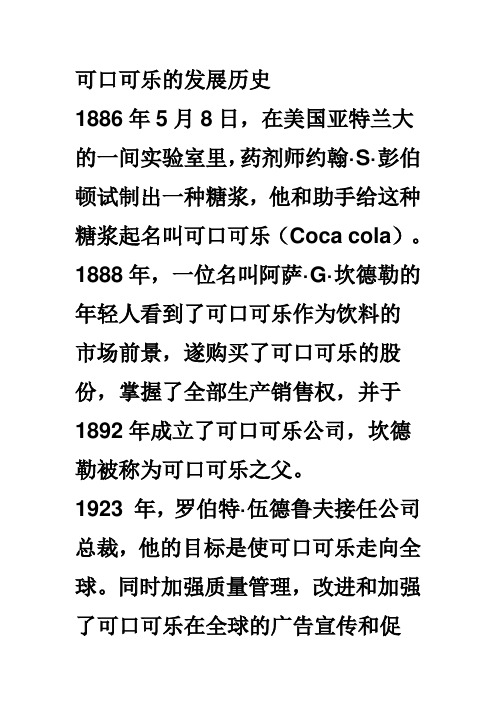
可口可乐的发展历史1886年5月8日,在美国亚特兰大的一间实验室里,药剂师约翰·S·彭伯顿试制出一种糖浆,他和助手给这种糖浆起名叫可口可乐(Coca cola)。
1888年,一位名叫阿萨·G·坎德勒的年轻人看到了可口可乐作为饮料的市场前景,遂购买了可口可乐的股份,掌握了全部生产销售权,并于1892年成立了可口可乐公司,坎德勒被称为可口可乐之父。
1923 年,罗伯特·伍德鲁夫接任公司总裁,他的目标是使可口可乐走向全球。
同时加强质量管理,改进和加强了可口可乐在全球的广告宣传和促销活动。
在伍德鲁夫的苦心经营下,可口可乐在全球得到推广,最终成为世界最有价值的品牌。
本世纪20年代,可口可乐就进入中国市场。
1927年,可口可乐在上海落户。
随后在天津、青岛也相继成立了装瓶厂。
中美建交后,可口可乐重返中国。
到目前为止,可口可乐已在中国投资了24家装瓶厂,投资额达到8 亿美元,是仅次于通用摩托罗拉的美国在华第三大投资商。
由于可口可乐是最早进入中国的美国的企业,具有百事可乐不可比拟的先入优势,百事可乐在中国同样处于挑战者的位置。
经营管理特点一是长期的企业形象目标的确立和实现,是其成为世界最有价值品牌的基本战略。
无论是可口可乐还是百事可乐都是世界上最早注重商标和品牌的企业。
二是巧妙、大手笔的营销策略。
有效、一致的广告和促销,注重包装和视觉形象,公司巨额的广告费投入以及在世界消费者心中的成功形象塑造,是不断取得进步的基础。
三品牌是活生生的、有个性的,好的品牌与消费者之间可建立起深厚的情感。
品牌必须考虑消费者使用和接受品牌的日常经验、感受、想法、态度和心理需求。
四树立品牌实际上是创造一种与众不同的个性。
可口可乐品牌的所有者一直认为:“我们成功的原因在于我们创造出的友善的氛围,消费者实际上是想与可口可乐融为一体。
”挡不住的诱惑:可口可乐的企业形象设计有人将可口可乐称为“魔水”,这种说法毫不夸张。
- 1、下载文档前请自行甄别文档内容的完整性,平台不提供额外的编辑、内容补充、找答案等附加服务。
- 2、"仅部分预览"的文档,不可在线预览部分如存在完整性等问题,可反馈申请退款(可完整预览的文档不适用该条件!)。
- 3、如文档侵犯您的权益,请联系客服反馈,我们会尽快为您处理(人工客服工作时间:9:00-18:30)。
Coca-Cola’s Economic
• Coca-Cola’s business in foreign currencies result in currency exposure of the company. • Strong U.S. dollar means weaker currencies elsewhere.
Coca-Cola’s Objectives
• Coca-Cola’s first objective is to maximize share owner value over time. • Maximize long-term cash flow • To ensure the strongest and most efficient production, distribution, and marketing systems possible
Coca-Cola’s Growth cont.
• During the 1960s and 1970s, CocaCola began diversifying its business. • Coca-Cola acquired more than 15 different businesses ranging from food, wine and soft drinks to film and water treatment. • 1982, Coca-Cola purchased Columbia Pictures selling off other businesses along the way.
Coca-Cola’s Marketing
• In 1997, Coca-Cola gave their products a “global facelift” • Created new graphics for packaging, POS materials, street signs, trucks and vending machines. • New global advertisement “Welcome to the World” • Put Coca-Cola “within an arm’s reach of desire”
– invest in bottling & concentrate plants – pay dividends to share owners – repurchases their shares
Coca-Cola’s I.S.
• Coca-Cola faces the threat of the Y2K problem with its computer programs and those of its suppliers/customers. • Coca-Cola has been proactive in the situation. • Coca-Cola will survey the company’s critical suppliers/customers to determine their status on Y2K compliance.
Coca-Cola’s Growth cont.
• Sept 12, 1919 Coca-Cola changed ownership once more. • Candler sold Coca-Cola as he pursued a position as mayor of Atlanta. • Ernest Woodruff purchased CocaCola with an investor group. • 1923- Robert Woodruff elected new President.
Coca-Cola’s Growth cont.
• 1899- Benjamin J. Thomas and Joseph B. Whitehead secured the exclusive rights to bottle and sell Coca-Cola for $1. • Thomas and Whitehead, with financial assistance from others, developed community bottling operations.
Coca-Cola’s External Environment
• External environment consists of:
– Economic – Social/Demographic – Ecological
– Political
Coca-Cola’s Economic
• Coca-Cola’s products are somewhat sensitive tonance
• Coca-Cola’s concentrate business is a cash cow. • In 1997, Coca-Cola generated $4 billion in operating cash flow • Coca-Cola invests this in 3 ways
Coca-Cola’s Growth cont.
• 1985, Coca-Cola changed its formula introducing New Coke. • New Coke was roundly rejected by consumers • Coca-Cola quickly brought back Coca-Cola Classic to meet customer demands.
– Loyal patrons, however, view Coca-Cola as an inexpensive pleasure – Disposable income is generally rising around the world
Coke is exactly the kind of company I like. I like products I can understand. I don’t know what a transistor is, but I appreciate the contents of a Coke can. Berkshire Hathaway’s purchase of stock in the Coca -Cola company was the ultimate case of me putting my money where my mouth was. -- Warren Buffett
Coca-Cola’s Growth
• Candler’s expertise in marketing led to massive growth in Coca-Cola. • 1894- Coca-Cola opened its first syrup manufacturing plant outside Atlanta in Dallas Texas. • Joseph Biedenharn became fist bottler of Coca-Cola in 1894
Coca-Cola’s History
• Invented in May of 1886 by Dr. John Styth Pemberton • First glass sold for 5 cents at Jacob’s Pharmacy in Atlanta • May 29, 1886- first newspaper advertisement pronounced it “Delicious and Refreshing”
Coca-Cola’s Growth cont.
• Mid 1980s, Coca-Cola came back to its roots to concentrate on the soft drink industry. • Coca-Cola adopted a product development effort with diet, caffeinefree, and citrus soft drinks • introduced POWERADE and Fruitopia in early 1990s.
Coca-Cola’s Operations
• Coca-Cola’s strategy of strengthening their distribution system, particularly in China and India. • Coca-Cola purchases underperforming bottling systems, improves them and sells them back to strong, existing bottlers. • This strategy increases the operational efficiency of Coca-Cola’s distribution.
Coca-Cola’s Development
• April 1888, Dr. Pemberton sold off his interest in Coca-Cola and passed away two days after. • April 1888, Asa Candler began buying up Coca-Cola shares • By 1892, Asa Candler was sole proprietor of Coca-Cola for a total investment of $2,300.
Coca-Cola’s Mission
Mission + Commitment = Focus Focus + Action = Results
